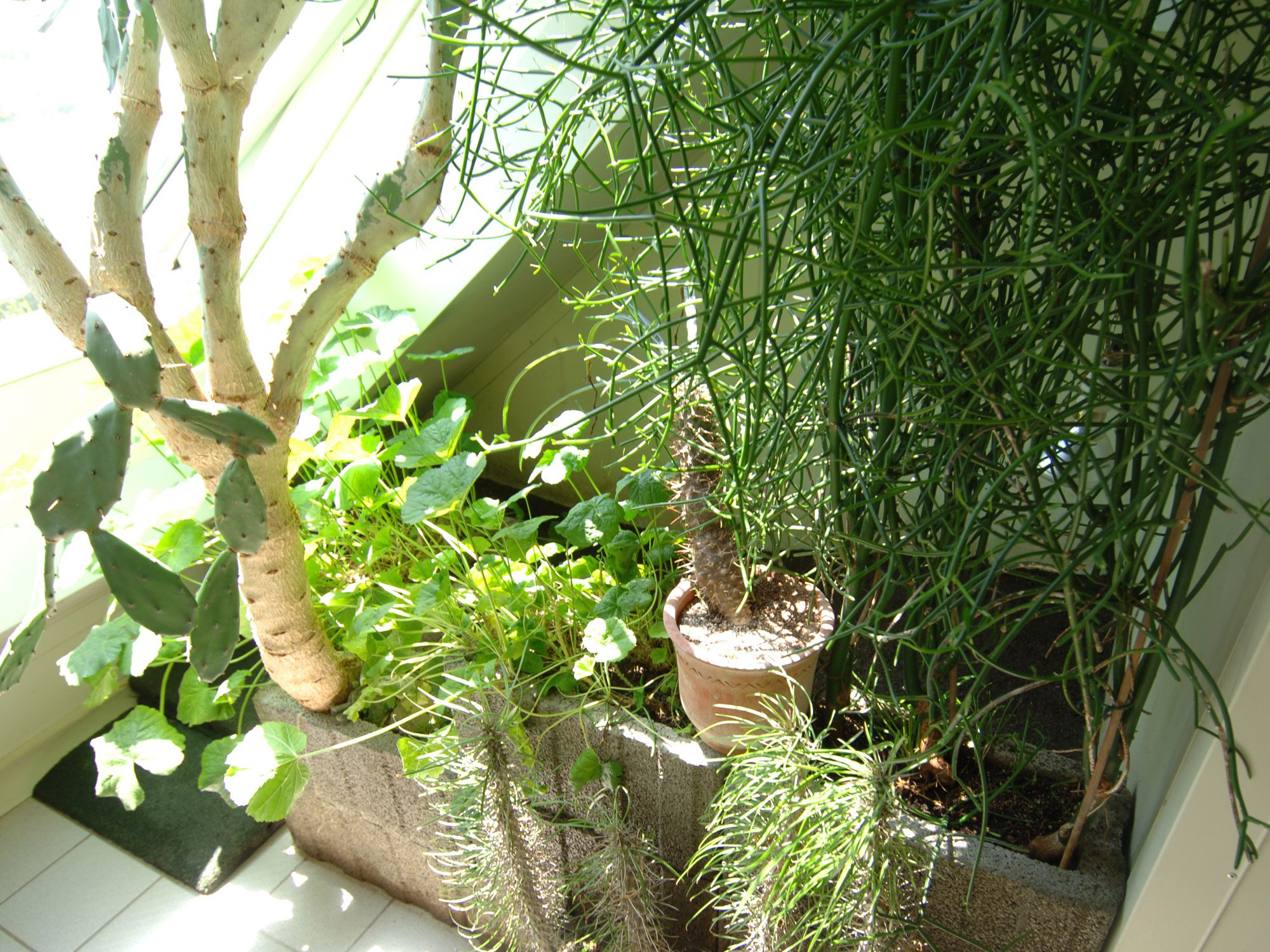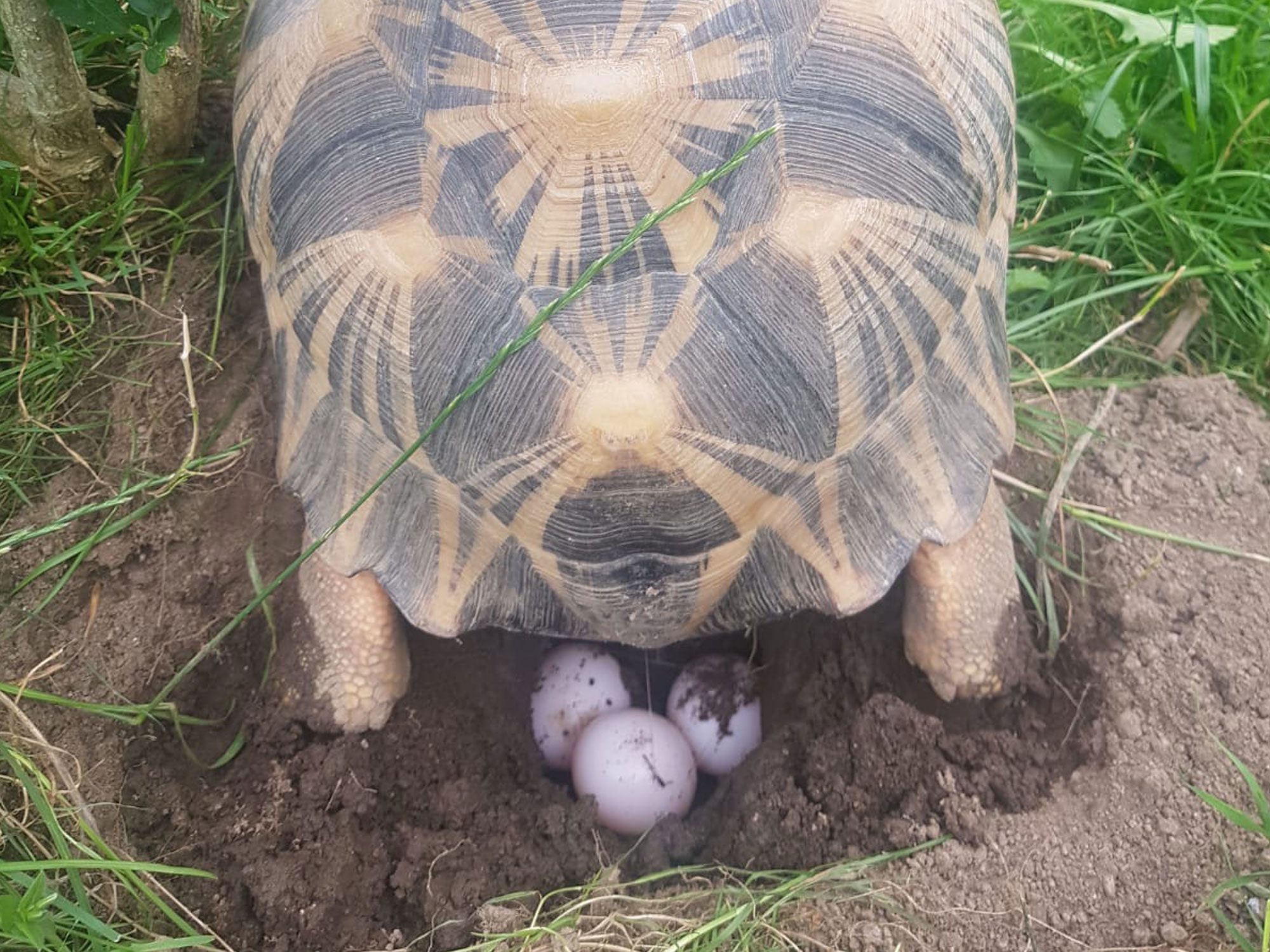Mehere Gelege sind im Jahr möglich
Bei der Zucht von Strahlenschildkröten ist darauf zu achten, dass den Weibchen das ganze Jahr über grosszügige Eiablageplätze sowohl im Innen- als auch im Aussengehege zur Verfügung stehen. Das Substrat bestehen aus einem Gemisch aus kompakter Gartenerde und Sand. Dieses sollte durchaus eine Tiefe von mindestens 30 cm besser 40 cm betragen und immer leicht feucht vorallem in den unteren Schichten sein. Der Eiablagehügel in unserem Innengehege ist über einer partiellen Bodenheizung erbaut und mittels einer Rampe aus rutschfesten Gummimatten für die Weibchen bequem erreichbar. Der Legehügel liegt unter einem Dachfenster, wodurch tagsüber ein wärmender Lichtkegel fällt. Zusätzlich ist noch ein Lucky Reptile Bright Sun Desert Strahler 150 Watt installiert, welcher bei Bedarf eingeschaltet werden kann. Der gesamte Legehügel ist mit einem leichten Sichtschutz aus Pflanzen umgeben, damit sich die Weibchen beim Graben ungestört und unbeobachtet fühlen. Sowohl der Legehügel im Innen- als auch Aussengehege kann abgetrennt werden, so dass die grabenden Weibchen nicht durch neugierige Artgenossen gestört werden. Auch wenn man während Pflegearbeiten keine Eiablage beobachten konnte, lohnt es sich, die Legehügel einmal im Monat auf heimliche abgelegte Eier zu untersuchen.
Bei einer bevorstehenden Eiablage stellen die Weibchen das Fressen ein und beginnen unruhig, suchend und den Boden beschnuppernd umherzuwandern. Hat das Weibchen eine geeignete Stelle gefunden, kratzt es zuerst an der Erdoberfläche und beginnt dann mit den Hinterbeinen abwechselnd ein Loch auszuheben. Je nach Bodenbeschaffenheit uriniert das Weibchen mehrmals um die Grabtätikeiten im harten Substrat zu erleichtern. In einer Tiefe von ca. 10 bis 15 cm wird am Boden der Grube eine Kammer ausgehöhlt. Ist diese zur Zufriedenheit des Weibchens fertiggestellt, hält sie inne und beginnt, im Abstand von ein paar Minuten ihre Eier auszupressen. Mit den Hinterbeinen werden diese geschickt am Boden der Nistgrube plaziert. Je nach Grösse des Weibchens umfasst ein Gelege 2 bis 6 Eier (in Ausnahmefällen können es auch mehr sein). Danach wird das Gelege sorgfälltig wieder zugebettet. Der gesammte Eiablagevorgang kann mehere Stunden dauern, wobei für das Bedecken der Eier und das Verwischen der Eiablagespuren immer sehr viel Zeit aufgewendet wird. Da beim Brutgeschäft durch das häufige Urinieren auch viel Flüssigkeit verloren geht, ist das Anbieten von Wasser und Futter nach der kräftezehrenden Eiablage eine Selbstverständlichkeit.
Meistens beginnt bei unseren Tieren die Eiablagesaison Anfang August und dauert bis in den Februar. Dabei wird im Abstand von 4 bis 6 Wochen immer wieder ein Gelege angelegt. Grundsätzlich sind aber das ganze Jahr über Gelege möglich, so werden auch vereinzelt von März bis Juli Eier abgelegt. Wir konnten schon Eiablagen im Frühjahr während den ersten Freigängen im Aussengehege bei kühlen 18°C beobachten. Vermutlich hat das natürliche und intensive Sonnenlicht die Weibchen zu einer spontanen Eiablage animiert. Die meisten unserer Weibchen haben pro Jahr 3 Gelege. Manche Weibchen setzten auch mal eine Saison aus, um dann wieder im folgenden Jahr Eier zu legen. Nur häufig bepaarte Weibchen scheinen auch regelmässig Eier zu legen. Die Eigrösse und das Gewicht der Eier können stark variieren und hängen in der Regel von der Grösse und dem Alter des Muttertieres ab.
Junge Weibchen produzieren bei ihren Erstgelegen noch ovale Eier, die meistens noch unbefruchtet sind, wobei ältere und grössere Weibchen stehts runde Eier legen. Es besteht ein direkter Zusammenhang zwischen der Qualität der Eier und dem Ernährungs- und Gesundheitszustand des Muttertiers. Haltungsfehler und Mangelerscheinungen haben einen negativen Einfluss auf die Zusammensetzung und Quantität des Eidotters sowie auf die Eigrösse und Schalendicke. Bei allzu schlechten Bedingungen werden unreife Eifollikel im Körper des Weibchens resorbiert und der Eireifezyklus über einen längeren Zeitraum hormonell ausgesetzt. Weibchen aus suboptimalen Haltungsbedingungen brauchen mehere Monate, manchmal Jahre unter guten Bedingungen bis der Eireifezyklus wieder aktiviert werden kann.
FAQ zum Themenbereich Paarung
Für eine gezielte und regelmässige Nachzucht von Astrochelys radiata braucht es vor allem Geduld und Ausdauer. Wird eine Gruppe Strahlenschildkröten bereits als Jungtiere zusammen grossgezogen, gewöhnen sich die Tiere unter relativ reizarmen und konstanten Bedingungen manchmal, einem alten Ehepaar gleich, derart aneinander, dass sie sich auch trotz erreichter Geschlechtsreife als regelrechte Paarungsmuffel erweisen. Wir empfehlen deshalb den Alltag der Tiere «reizvoller» zu gestalten. Das gleichzeitige Anheben der Temperatur auf 30 bis 35°C und Luftfeuchtikeit auf 80%, sowie regelmässige Aufenthalte an der Sonne und frischen Luft wirken wahre Wunder. Auch das Abtrennen der Geschlechter für mehere Wochen, ohne dass sich die Tiere sehen und riechen können, wirkt bei einem Wiedersehen sehr stimulierend. Berücksichtig man das ritualisierte Paarungsverhalten der Tiere, ist die Anwesenheit von meheren Männchen ebenfalls von Vorteil. Vergewissern Sie sich kritisch, ob alle Haltungsparamenter auch konsequent umgesetzt wurden. Falls keine der Massnahmen nach mehrfacher Wiederholung greifen sollte, ist eine Neuzusammenstellung der Gruppe mit Austausch einzelner Exemplare in Betracht zu ziehen. In seltenen Fällen kann auch eine durch Viren oder Bakterien verursachte Enzündung und Degenerierung der Eierstöcke mit irreversiebler Unfruchtbarkeit vorkommen. Wir halten ein regelmässiges Zuchtprogramm von Astrochelys radiata in einer Indoorhaltung, ohne Zugang zu natürlichem Sonnenlicht, für ausgeschlossen.


